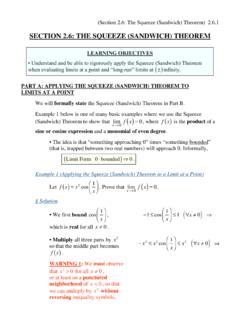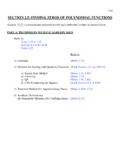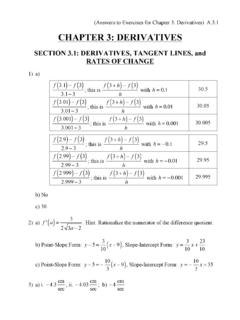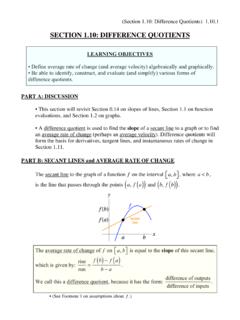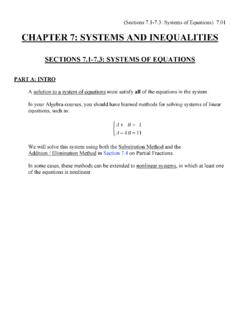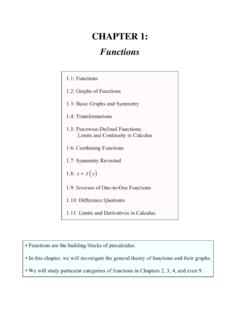Transcription of SECTION 3.4: DERIVATIVES OF TRIGONOMETRIC FUNCTIONS
1 ( SECTION : DERIVATIVES of TRIGONOMETRIC FUNCTIONS ) SECTION : DERIVATIVES OF TRIGONOMETRIC . FUNCTIONS . LEARNING OBJECTIVES. Use the Limit Definition of the Derivative to find the DERIVATIVES of the basic sine and cosine FUNCTIONS . Then, apply differentiation rules to obtain the DERIVATIVES of the other four basic TRIGONOMETRIC FUNCTIONS . Memorize the DERIVATIVES of the six basic TRIGONOMETRIC FUNCTIONS and be able to apply them in conjunction with other differentiation rules. PART A: CONJECTURING THE DERIVATIVE OF THE BASIC SINE. FUNCTION. Let f ( x ) = sin x . The sine function is periodic with period 2.
2 One cycle of its graph is in bold below. Selected [truncated] tangent lines and their slopes (m) are indicated in red. (The leftmost tangent line and slope will be discussed in Part C.). Remember that slopes of tangent lines correspond to derivative values (that is, values of f ). The graph of f must then contain the five indicated points below, since their y-coordinates correspond to values of f . Do you know of a basic periodic function whose graph contains these points? ( SECTION : DERIVATIVES of TRIGONOMETRIC FUNCTIONS ) We conjecture that f ( x ) = cos x . We will prove this in Parts D and E.
3 PART B: CONJECTURING THE DERIVATIVE OF THE BASIC COSINE. FUNCTION. Let g ( x ) = cos x . The cosine function is also periodic with period 2 . The graph of g must then contain the five indicated points below. Do you know of a (fairly) basic periodic function whose graph contains these points? ( SECTION : DERIVATIVES of TRIGONOMETRIC FUNCTIONS ) We conjecture that g ( x ) = sin x . If f is the sine function from Part A, then we also believe that f ( x ) = g ( x ) = sin x . We will prove these in Parts D and E. PART C: TWO HELPFUL LIMIT STATEMENTS. Helpful Limit Statement #1. sin h lim =1.
4 H 0 h Helpful Limit Statement #2. cos h 1 1 cos h . lim = 0 or, equivalently, lim = 0 . h 0 h h 0 h . These limit statements, which are proven in Footnotes 1 and 2, will help us prove our conjectures from Parts A and B. In fact, only the first statement is needed for the proofs in Part E. sin x Statement #1 helps us graph y = . x sin x In SECTION , we proved that lim = 0 by the Sandwich (Squeeze). x x sin x Theorem. Also, lim = 0. x x sin x Now, Statement #1 implies that lim = 1 , where we replace h with x. x 0 x sin x sin x Because is undefined at x = 0 and lim = 1 , the graph has a hole x x 0 x at the point ( 0, 1).
5 ( SECTION : DERIVATIVES of TRIGONOMETRIC FUNCTIONS ) (Axes are scaled differently.). Statement #1 also implies that, if f ( x ) = sin x , then f ( 0 ) = 1 . f (0 + h) f (0). f ( 0 ) = lim h 0 h sin ( 0 + h ) sin ( 0 ). = lim h 0 h sin h 0. = lim h 0 h sin h = lim h 0 h =1. This verifies that the tangent line to the graph of y = sin x at the origin does, in fact, have slope 1. Therefore, the tangent line is given by the equation y = x . By the Principle of Local Linearity from SECTION , we can say that sin x x when x 0 . That is, the tangent line closely approximates the sine graph close to the origin.
6 ( SECTION : DERIVATIVES of TRIGONOMETRIC FUNCTIONS ) PART D: STANDARD PROOFS OF OUR CONJECTURES. DERIVATIVES of the Basic Sine and Cosine FUNCTIONS 1) Dx ( sin x ) = cos x 2) Dx ( cos x ) = sin x Proof of 1). Let f ( x ) = sin x . Prove that f ( x ) = cos x . f ( x + h) f ( x ). f ( x ) = lim h 0 h sin ( x + h) sin ( x ). = lim h 0 h by Sum Identity for sine . sin xcos h + cos xsin h sin x = lim h 0 h Group terms with sin x.. = lim (sin xcos h sin x ) + cos xsin h h 0 h = lim (sin x )(cos h 1) + cos xsin h h 0 h ( Now, group expressions containing h.).. cos h 1. sin h . h 0 . (. = lim sin x ).
7 H ( ). + cos x . h .. 0 1 . = cos x . ( SECTION : DERIVATIVES of TRIGONOMETRIC FUNCTIONS ) Proof of 2). Let g ( x ) = cos x . Prove that g ( x ) = sin x . (This proof parallels the previous proof.). g ( x + h) g ( x ). (). g x = lim h 0 h cos ( x + h) cos ( x ). = lim h 0 h by Sum Identity for cosine . cos xcos h sin xsin h cos x = lim h 0 h Group terms with cos x.. = lim (cos xcos h cos x ) sin xsin h h 0 h = lim (cos x )(cos h 1) sin xsin h h 0 h ( Now, group expressions containing h.).. cos h 1. sin h . h 0 . (. = lim cos x ) . h ( ). sin x . h .. 0 1 . = sin x Do you see where the sign in sin x arose in this proof?
8 ( SECTION : DERIVATIVES of TRIGONOMETRIC FUNCTIONS ) PART E: MORE ELEGANT PROOFS OF OUR CONJECTURES. DERIVATIVES of the Basic Sine and Cosine FUNCTIONS 1) Dx ( sin x ) = cos x 2) Dx ( cos x ) = sin x Version 2 of the Limit Definition of the Derivative Function in SECTION , Part A, provides us with more elegant proofs. In fact, they do not even use Limit Statement #2 in Part C. Proof of 1). Let f ( x ) = sin x . Prove that f ( x ) = cos x . f ( x + h) f ( x h). f ( x ) = lim h 0 2h sin ( x + h) sin ( x h). = lim h 0 2h by Sum Identity for sine by Difference Identity for sine . = lim (sin xcos h + cos xsin h) (sin xcos h cos xsin h).
9 H 0 2h 2 cos xsin h = lim h 0 2h sin h . h 0 . (. = lim cos x ) h .. 1 . = cos x . ( SECTION : DERIVATIVES of TRIGONOMETRIC FUNCTIONS ) Proof of 2). Let g ( x ) = cos x . Prove that g ( x ) = sin x . g ( x + h) g ( x h). (). g x = lim h 0 2h cos ( x + h) cos ( x h). = lim h 0 2h from Sum Identity for cosine from Difference Identity for cosine .. = lim (cos xcos h sin xsin h) (cos xcos h + sin xsin h). h 0 2h 2 sin xsin h = lim h 0 2h sin h . h 0 . (. = lim sin x ) h .. 1 . = sin x . ( SECTION : DERIVATIVES of TRIGONOMETRIC FUNCTIONS ) A Geometric Approach Jon Rogawski has recommended a more geometric approach, one that stresses the concept of the derivative.
10 Examine the figure below. Observe that: sin ( x + h ) sin x h cos x , which demonstrates that the change in a differentiable function on a small interval h is related to its derivative. (We will exploit this idea when we discuss differentials in SECTION ). sin ( x + h ) sin x Consequently, cos x . h sin ( x + h ) sin ( x ). In fact, Dx ( sin x ) = lim = cos x . h 0 h cos ( x + h ) cos ( x ). A similar argument shows: Dx ( cos x ) = lim = sin x . h 0 h Some angle and length measures in the figure are approximate, though they become more accurate as h 0 . (For clarity, the figure does not employ a small value of h.)

